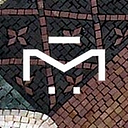The best modern tile materials to make a mosaic
We all know that traditionally mosaic art is made of small squarish pieces of stone or glass, otherwise known as tesserae. However, times have changed and so have the ways of mosaic making. Today you can make a gorgeous mosaic artwork out of virtually anything, from candy to tech waste.
GLASS TESSERAE
Glass mosaic making started in Burma and it was traditionally used for decorative purposes and was usually studded with semi-precious stones and gems. Modern glass mosaics can be divided into three most vastly present categories: vitreous glass tesserae, clear glass tesserae, and smalti tesserae mosaic art.
Vitreous glass tesserae are most often used for swimming pools, showers, and bathroom backsplashes. The tesserae are vitrified, so they are textured on one side and smooth on the other. The edges of the tesserae are slightly rounded which makes them safer for use. It is the more affordable material of the two and there is a larger variety of it accessible on the market.
Clear glass tesserae are usually used by the veteran of mosaic art, as they are more difficult to properly manipulate to make a particular optical effect. Clear glass tiles allow light to pass through either partially or diffusely and they can be both have a color or not. Clear glass tesserae come in a variety of forms, most popular of which are back-colored clear glass tiles, stained clear glass tiles, and transparent clear glass tiles.
Smalti tesserae are traditionally created Italian handmade opaque glass, stained and infused with a variety of different minerals. It is the most expensive of all glass tesserae due to the minerals that are used during its formulation. These precious minerals can often include silver and even golden leaves.
MARBLE OR STONE TESSERAE
Marble or natural stone tesserae are the most basic materials used in mosaic making. First marble and stone mosaic art can be traced back to 600 BC when it was used by the Sumerians. Natural stone was easy to source and cut with simple tools, and it was highly durable which made it perfect for creating pathways and decorating outdoor locations. One of the forms of natural stone that were vastly used for external mosaic making and didn’t require any cutting was also pebbles.
PORCELAIN AND CERAMIC TESSERAE
Porcelain and ceramic tiles are easily sourced and very popular among amateur mosaicists. The main difference between the two lies in the rate of water they can potentially absorb. The clay of which porcelain tiles are made is much denser and less porous, so it will absorb less than 0.5% of water than the clay used for ceramic tiles.
ALTERNATE MOSAIC MAKING MATERIALS
Alternate mosaic materials can be either natural, such as seas shells, dried legumes, wood, etc., or artificial, such as bottle caps, coins, buttons, etc. When it comes to alternate mosaic materials the list is practically endless. Some prominent modern mosaicists use eggshells, candy wrappers, photographs, and more.
This is supposed to be a pretty straight-to-the-point blog post, but it wouldn’t be MY blog post without my personal opinion on the matter. As sharp as I can be sometimes, there really isn’t much I can pitch in here, but there is one important piece of advice I’d like to give to all the upcoming mosaicists out there. Whichever material you choose, make sure it’s sustainable, because beauty and sustainability are what mosaic art future should be all about.
